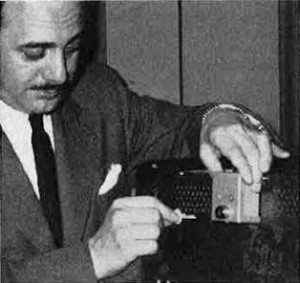|
On-demand television is
a concept that has existed about since the time commercial broadcast TV first came
on the scene. Known as "Boxoffice Television," it used a "Picture-caster" to scramble
the picture so that a subscriber needed a rented descrambler in order to view the
program. A rented key (physical, not digital) was used to turn the box on and off.
The signal went out over a standard local broadcast tower or even over coaxial line.
Channels 2 through 13 were it for the day. This particular article appeared in
Radio & Television News magazine in 1953. Also, "Will You Pay for TV?," in a 1957 Radio & Popular Electronics
and "Stop Pay TV!," in a 1958 Radio-Electronics.
Thanks to Terry W. for providing this article.
New "Pay-As-You-Watch" System

Max Genodman, president of United Elco (a contracting firm specializing in hotel
master antenna system installation), inserts the decoding key in the rear of a television
set equipped to receive Boxoffice Television's enclosed-circuit TV.

Lee Bunting, treasurer of Bell Television, Inc. (a master antenna TV system operating
firm), is shown with a demonstration set-up incorporating the new "Picturecaster"
and the TV set with which it is employed.
Boxoffice Television's new closed-circuit transmitter for TV makes possible retransmissions
on Channels 2 through 13.
The ever-mounting cost of television program sponsorship is causing more and
more companies to cast a tentative eye at the various "TV-for-pay" systems which
have been developed in the past few years.
Although not as yet sanctioned by the FCC, several companies are proceeding with
the development of equipment to handle this type of transmission.
Among the new items on the market is Boxoffice Television's "Picture-caster",
a unique closed-circuit transmitter for television pictures and sound.
The unit accepts video and audio from any source - a receiver, camera chain,
coaxial line, generator, etc. and transmits them into any type of transmission line
on any v.h.f. channel, 2 through 13. The transmitter frequency is crystal-controlled,
with the sound and video carriers automatically maintained 4.5 mc. apart for best
results with inter carrier receivers. AM pictures and FM sound are receivable on
all standard TV sets.
The system as it operates now, in conjunction with master antenna systems, is
inexpensive and easily installed and operated.
The audio and video are piped by a common carrier (such as telephone company
lines) to each master antenna system which is part of the network. These normal
signals are then fed into the "Picture caster" which scrambles the picture so that
while it can be tuned in in the normal way it cannot be viewed.
The special decoder with which the receiving set is equipped consists of an inexpensive
tube circuit, which is installed in one of the receiver's existing tube sockets,
and a box with a keyhole.
To view an unscrambled picture, the user inserts the key in the key-hole and
the picture comes in clear. Keys can be rented for various periods of time, the
rental depending on the program material to be received. The key rental is the fee
for watching the program. Removing the key scrambles the picture again so that a
single key cannot be used to operate several receivers.
The equipment is undergoing extensive testing at the present time in anticipation
of an FCC OK on "Pay-As-You-Watch" programming.
Posted December 30, 2021
(updated from original post on 5/27/2013)
|









